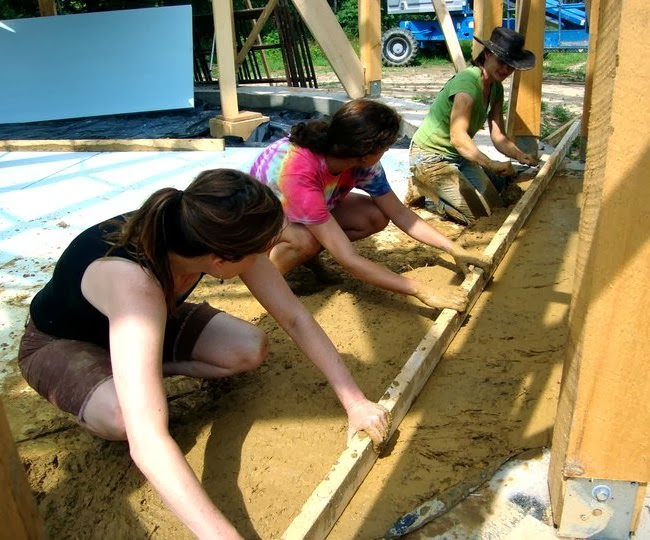Thanks to Sigi Koko of Build Naturally.
I do a 2-layer adobe floor, mostly because this allows me to pour the thick base layer before the exterior walls are completely closed in. That extra air-flow speeds up drying time (and eliminates a highly humid interior later in construction). I use the same proportions I would for cob, which is generally 15 to 25% total clay plus 75 to 85% concrete sand. The difference is that I add lots more water. With cob, the wetter your mix, the more your cob wants to splooge on your walls, so it prevents you from building higher until the material dries. However, with a floor, you want to be able to pour it, like a really thick liquid. (I use about the consistency of chocolate pudding.) If I am using clay soil from the site, I sift it pretty large…through a 1/2″ screen is fine. To this mix, you want to add long fiber, and lots of it. The fiber knits the floor together and helps prevent cracking in the clay. I use straw, since it is abundant in my region.
The process for laying this layer is pretty simple.
- make a batch of your mix
- place the mix at the farthest corner of your floor, where you are going to begin
- make sure you have height reference points in place (such as a perimeter beam or braced ledger boards)
- roughly pack the mixture into place, being sure to push into any corners or voids (you can literally throw the adobe into the corners to be sure you get good fill); make sure your material is filled a bit higher than you want your finished layer to end up
- level the floor with a long, straight 2×4 by holding each end of the board on your ledgers (so you know your height) and then shimmy the board back-and-forth while pulling slowly toward you (the longer your leveling board, the more hands on deck you need to shimmy it); as material builds up in front of your board, it makes it more difficult to move the 2×4, so simply stop, scrape the excess out of your way, and carry on
- then let the floor dry completely (and don’t let it freeze until it is 100% dry)
Note that it is perfectly normal to get some sprouting in your floor as it dries. Do not be alarmed if this happens! It’s just seeds from your straw confusing your floor for a garden. As soon as the floor dries, the sprouts will die, leaving behind some additional fiber reinforcing from their root structure.
Another option for this base layer is to make adobe bricks. You are using the same exact mixture but placing it in forms and then letting the adobe dry out in the sun. The benefit here is that you can carry on with construction, without having to wait for a thick, wet floor to dry so you can walk around unimpeded. Once your bricks are dry, you lay them like patio pavers in a layer of sand, tamping them to level as you go.
 |
| Leveling the adobe with a long, straight 2×4. |
 |
| This first layer just needs to be level, but it can have pock marks (this 550 SF floor took 1 day for about 15 people to install). |
